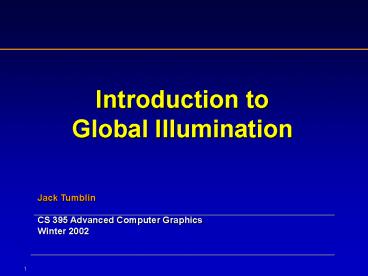Picture Perception for Humans PowerPoint PPT Presentation
Title: Picture Perception for Humans
1
Introduction to Global Illumination
Jack Tumblin CS 395 Advanced Computer
Graphics Winter 2002
2
Global Illumination
- Physical Simulation of Light Transport
- Accuracyaccount for ALL light pathsconservation
of energy - Predictionforward renderingcalculate light
meter readings - Analysisinverse rendering! find surface
properties ! - Realism?perceptually necessary?
3
Local Illumination
- Everything is lit by Light Sources
- Screen color light source surface reflectance
- Refinements reflectance specular, diffuse,
ambient, texture, light directshadow
ambientenvironment maps,
4
Local Illumination
- Everything is lit by Light Sources
- Refine point light source ? Area light source
- Result? hard shadows ? soft shadows
5
Global Illumination
- Everything is lit by Everything Else
- Screen color entire scene surface reflectance
- Refinements Models of area light sources,
caustics, soft-shadowing, fog/smoke,
photometric calibration,
H. Rushmeier et al., SIGGRAPH98 Course 05 A
Basic Guide to Global Illumination
6
Global Illumination
- Idea ALL POSSIBLE PATHS of light source to eye
From Jensen et al., SIGGRAPH2000 Course 20 A
Practical Guide To Global Illumination Using
Photon Maps
7
Global Illumination
- Idea ALL POSSIBLE PATHS of light source to eye
From Jensen et al., SIGGRAPH2000 Course 20 A
Practical Guide To Global Illumination Using
Photon Maps
8
Limitations
- Geometric Optics Only
- All objects, apertures gtgt ? (wavelength)
- YES Reflection, Refraction, Scattering
- No fringes, diffraction, dispersion (see
movie) - Point-Based BRDF (see Wann-Jensen et
al.SIGGRAPH2001
9
Summary I
- Big Ideas
- Measure Light Radiance
- Measure Light Attenuation BRDF
- Light will bounce around endlessly, decaying on
each bounce The Rendering Equation
(intractable must
approximate)
10
Review Surface Properties
- Perfectly Specular
- Mirror
- infinite gloss
- Phong Specular Model
- L R cos?(?)
Incident LightRay
SurfaceNormal
ReflectedLight
?
Andrew Glassner et al.. SIGGRAPH94 Course
18 Fundamentals and Overview of Computer
Graphics
11
Review Surface Properties
- Slightly scattered Specular
- high gloss
- Phong Specular Model
- L R cos15(?)
Incident LightRay
SurfaceNormal
ReflectedLight
Andrew Glassner et al.. SIGGRAPH94 Course
18 Fundamentals and Overview of Computer
Graphics
12
Review Surface Properties
- More Scattered Specular
- medium gloss
- Phong Specular Model
- L R cos5(?)
Incident LightRay
SurfaceNormal
Andrew Glassner et al.. SIGGRAPH94 Course
18 Fundamentals and Overview of Computer
Graphics
13
Review Surface Properties
- Perfectly Diffuse
- flat, chalky,
Incident LightRay
SurfaceNormal
Andrew Glassner et al.. SIGGRAPH94 Course
18 Fundamentals and Overview of Computer
Graphics
14
Review Surface Properties
- Most Materials
- Combination of
- Diffuse and Specular
Incident LightRay
SurfaceNormal
Andrew Glassner et al.. SIGGRAPH94 Course
18 Fundamentals and Overview of Computer
Graphics
15
Point-wise Reflectance BRDF
- Bidirectional Reflectance Distribution Function
- ?(?i , ?i , ?r , ?r , ?i , ?r , ) (Lr
/ Li) a scalar
Illuminant Li
Reflected Lr
Infinitesimal Solid Angle
?
?
16
Point-wise Light Radiance L
- Radiance The Pointwise Measure of Light
- Free-space light power L (energy/time)
- At least a 5D scalar function L(x, y, z, ?, ?,
) - Position (x,y,z), Angle (?,?) and more (t, ?, )
- Power density units, but tricky
17
Radiance Units
- Tricky think Hemispheres
- with a floor
Solid Angle (steradians) dS fraction of
a hemispheres area (4?)
Projected Area
cos ? dA
?
dA
dA
18
Rendering Equation
(Kajiya 1986)
- .
Radiance from point
Radiance emitted from point
Radiance reflected from point (from all inward
directions)
19
Rendering Equation
- Opportunities
- Scalar operations only ?() and L(), indep. of ?,
x,y,z, ?,? - Linearity
- Solution weighted sum of one-light solns.
- Many BRDFs ? weighted sum of diffuse, specular,
gloss terms - SIGGRAPH2001 Result reflected light
convolution(Lin, ?) - Difficulties
- Almost no notrivial analytic solutions exist
MUST use approximate methods to solve - Verification tough to measure real-world ?() and
L() well - Notable wavelength-dependent surfaces exist
(iridescent insect wings casing, CD grooves) - BRDF doesnt capture important subsurface
scattering
20
Implementation I
- Practical Approximations
- Diffuse-only reflectance Radiosity Solution
- Book presents old, slow, exact Gauss-Seidel
- Bounce-by-Bounce Progressive Refinement, Path
Tracing - Object-space Storage Adaptive Meshing
21
Remeshing Example
22
Progressive Radiosity
23
Implementation II
- Practical Approximations
- From Both Ends Bi-directional Tracing,
- Trace from light to surfaces store result, then
- Trace from eye to surfaces
- Scattering Rays where needed
- Monte-Carlo Methods,
- Distributed Ray Tracing
- Hybrids
- Numerical Methods (Galerkin, etc.),
- Photon Maps,
- Metropolis Transport,
- Particles, Illumination caching,
- 4D light volume sampling
24
Example Photon Maps
- Ideal Trace Photon Paths
- Trouble high compute costs (exponential)
- Photon Maps A Hybrid Solution
- big, sticky, aggregate photons
- Russian Roulette (reflect, transmit, absorb?)
- Trace photons outwards from light sources
- Store photons only at diffuse surfaces
- Scattered data interp.,
- Cache photons/illum. at each step.
25
Example Photon Maps
- Forward-traced Reverse-TracedPhoton
Map Result
26
Photon Map Result
- .
27
Conclusion
- Physically accurate (geometric optics only)
simulation of light transport. - Ultimate Realism? perceptual, not physical
- Languished as tweak-hungry lab curiosity
- Gradual adoption for multitexturing source, for
mixing real/synthetic images, Ph.Ds,
theatre/architectural lighting, archaeology, - Growing interest for use in inverse rendering
tasks image-based rendering modeling

